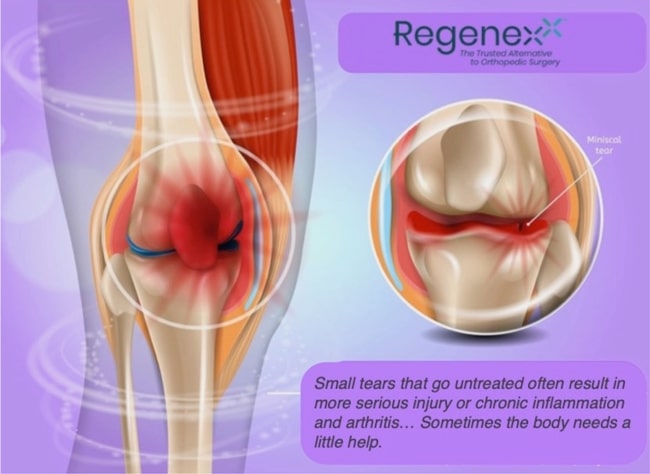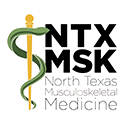Meniscus tears are one of the most common types of knee injuries. When left untreated, the tear may increase, making the knee become susceptible to arthritis. Symptoms of meniscus tear include: pain, stiffness, reduced range of motion, and swelling.
Each knee has two C-shaped pieces of cartilage that act like a cushion between your tibia and your femur. Most commonly, the meniscus is injured during sports by aggressively rotating or twisting the knee. The second cause of meniscus injury is degeneration of the cartilage. As the tissue gradually weakens with age, it becomes brittle and less pliable. More than 40% of people 65 or older have tears to knee tissue.
Read more about types of meniscus tears.
Why Treatment is Necessary
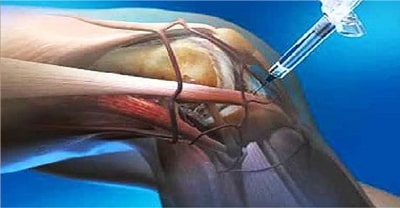
Meniscus tissue is composed of collagen, the most abundant protein in the body. When tiny tears occur from excess strain or sprain, the connective tissue generally does not heal quickly or completely. Muscle tissue has a healthy flow of blood that adequately supplies nutrients, growth factors, and oxygen, while removing metabolic waste to prepare the site for healing. This is apparent in the red color of muscles. Ligaments, tendons and cartilage, however, are white in color, as the blood supply to these tissues is poor.
The oxygen consumption of tendons and ligaments is 7.5 times lower than that of skeletal muscles. The low metabolic rate and well-developed anaerobic energy generation capacity are essential to carry loads and maintain tension for long periods. However, a low metabolic rate results in slow healing after injury. When acute or chronic injury occurs in these tissues, healing is slow and often incomplete.
Blood flow is crucial in the healing process. The outer one-third of the meniscus has a blood supply and is referred to as the red zone. Tears in this area are typically more likely to heal on their own. The inner two-thirds of the meniscus have only a limited blood supply, which is why it is called the white zone.
The liquid portion of blood, plasma, acts as a transport medium for blood cells, nutrients, and removal of metabolic waste products to prepare the site for healing. Platelets, once thought to merely help with blood clotting, contain growth factors called alpha granules and help to stimulate the release of localized stem cells. When the amount of localized stem cells and necessary nutrients required for healing become depleted or the body is able to supply only limited blood flow, healing sometimes needs a little help. Learn more about tendon injury.
Different tissues have different blood flow and different metabolic rates. Cartilage in the meniscus, like other collagenous tissue, has extremely poor circulation. Where blood supply is low, degeneration often occurs due to low oxygen levels and inadequate supply of nutrients and growth factors needed for healing. Inadequate blood flow causes injuries to heal slowly and generally incompletely. Areas with poor circulation are also difficult for stem cells to reach and for cell signaling to be effective, key elements in the Emergency Medical Team our body uses to heal. Learn more about musculoskeletal healing.
Treatment of meniscus injury
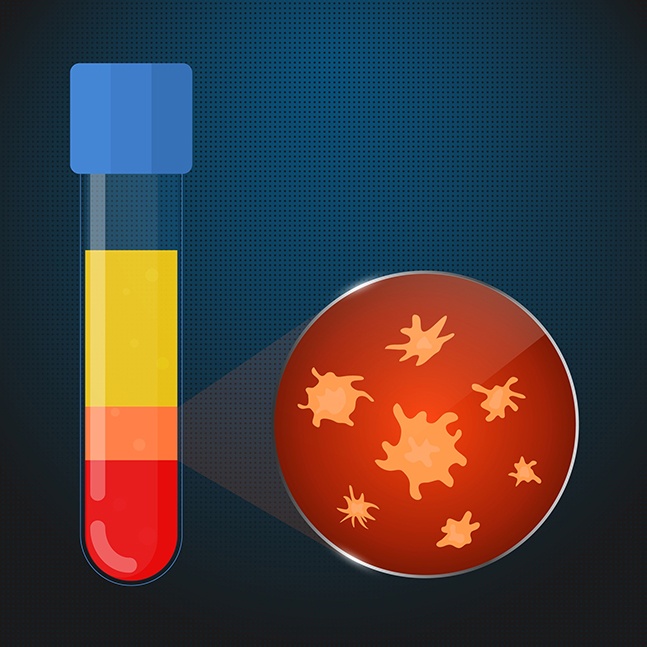
If injury to the meniscus is small and located in the “red zone,” it may heal over time with rest and ice to control inflammation. Meniscus tears generally, however, do not heal completely or quickly. Treatment is recommended.
Despite research showing that corticosteroids damage orthopedic tissues, such as joints and tendons, they have become a quick fix used by many physicians. Information showing that cortisone is bad for joint tissue since dates back to 1951. Since then, evidence has grown. Recently the Journal of the American Medical Association published a randomized controlled trial. The study showed that patients with knee arthritis who received steroid shots for knee arthritis not only showed no improvement over saline injections, but they also had an accelerated loss of cartilage.
So why are these still used? Cortisone injections temporarily stop the pain of injured joints by reducing inflammation. However, the body heals by Inflammation. When a person sprains an ankle, the persistent swelling for one to three days is the body’s attempt to heal the area. The healing cascade resulting from a rush of cells to the damaged area is inhibited by cortisone as it minimizes the migration of the immune cells to the injured area. Cortisone, also known as “steroid injections,” will reduce inflammation, but in turn inhibit healing and further damage cartilage. Healing is sacrificed for pain control. Read more about musculoskeletal healing.
In one recent study, the authors looked at almost four thousand patients who were part of a government-funded arthritis study. Each steroid shot in the knee increased the likelihood of needing a knee replacement by 9%. Meaning, if you got 4 steroid shots to help arthritis pain, this increased the likelihood that you would need a knee replacement by about 36%!
What about surgical repair of the meniscus? Arthroscopic surgery to “repair the meniscus and clean up the joint” has been shown to be no better than placebo in treating patients’ pain at 1-year post surgery (New England Journal of Medicine 2013). Other studies show that the procedure accelerates osteoarthritic changes in the knee and lead to premature knee replacement surgeries. This has led to the American Academy of Orthopedic Surgeons (AAOS) advise against knee surgery for the majority of meniscus tears regardless of the imaging study evidence, mechanical symptoms, or sudden onset of symptoms.
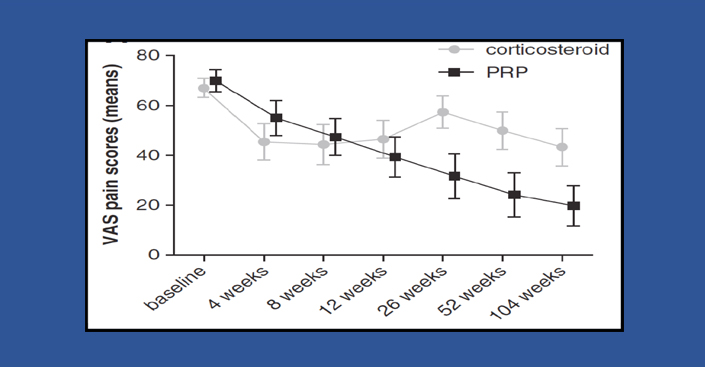
Bone Marrow Stem Cell Therapy and Platelet Rich Plasma (PRP)
An increasing demand for healthcare treatment that emphasizes the body’s immune system and natural healing process is changing medicine. As research discovers more about how this works, physicians are better able to explore more and better treatments. These innovative procedures have shown to be extremely effective in treatment of orthopedic conditions.
A 2023 meta-analysis by Chris Centeno, MD, Founder of Regenexx, examined the published literature on interventional orthobiologics, specifically on PRP for all musculoskeletal indications. Not only has the number of randomized controlled trials (RCTs) on PRP significantly increase recently, but he found that there is more and better literature support for the use of PRP in many orthopedic indications than exists for orthopedic surgery as a field.
